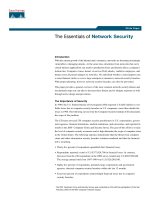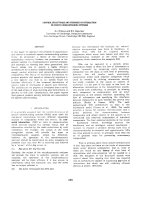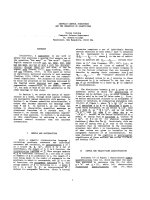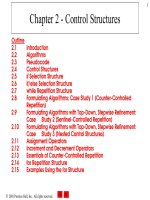Control Structures _ Essentials of Counter-Controlled Repetition
Bạn đang xem bản rút gọn của tài liệu. Xem và tải ngay bản đầy đủ của tài liệu tại đây (201.39 KB, 31 trang )
2003 Prentice Hall, Inc. All rights reserved.
30
Essentials of Counter-Controlled Repetition
• Counter-controlled repetition requires
– Name of control variable/loop counter
– Initial value of control variable
– Condition to test for final value
– Increment/decrement to modify control variable when
looping
2003 Prentice Hall, Inc.
All rights reserved.
1 // Fig. 2.16: fig02_16.cpp
2 // Counter-controlled repetition.
3 #include <iostream>
4 using std::cout;
5 using std::endl;
6 // function main begins program execution
7 int main()
8 {
9 int counter = 1; // initialization
10 while ( counter <= 10 ) { // repetition condition
11 cout << counter << endl; // display counter
12 ++counter; // increment
13 } // end while
14 return 0; // indicate successful termination
15 } // end function main
2003 Prentice Hall, Inc.
All rights reserved.
1
2
3
4
5
6
7
8
9
10
2003 Prentice Hall, Inc. All rights reserved.
33
for Repetition Structure
• General format when using for loops
for ( initialization; LoopContinuationTest;
increment )
statement
•Example
for( int counter = 1; counter <= 10; counter++ )
cout << counter << endl;
– Prints integers from one to ten
No
semicolon
after last
statement
2003 Prentice Hall, Inc.
All rights reserved.
1 // Fig. 2.17: fig02_17.cpp
2 // Counter-controlled repetition with the for structure.
3 #include <iostream>
4 using std::cout;
5 using std::endl;
6 // function main begins program execution
7 int main()
8 {
9 // Initialization, repetition condition and incrementing
10 // are all included in the for structure header.
11 for ( int counter = 1; counter <= 10; counter++ )
12 cout << counter << endl;
13 return 0; // indicate successful termination
14 } // end function main
2003 Prentice Hall, Inc. All rights reserved.
35
for Repetition Structure
• for loops can usually be rewritten as while loops
initialization;
while ( loopContinuationTest){
statement
increment;
}
• Initialization and increment
– For multiple variables, use comma-separated lists
for (int i = 0, j = 0; j + i <= 10; j++, i++)
cout << j + i << endl;
2003 Prentice Hall, Inc. All rights reserved.
36
Examples Using the for Structure
• Program to calculate compound interest
• A person invests $1000.00 in a savings account yielding 5 percent
interest. Assuming that all interest is left on deposit in the account,
calculate and print the amount of money in the account at the end of
each year for 10 years. Use the following formula for determining
these amounts:
a = p(1+r)
• p is the original amount invested (i.e., the principal),
r is the annual interest rate,
n is the number of years and
a is the amount on deposit at the end of the nth year
n
2003 Prentice Hall, Inc.
All rights reserved.
1 // Fig. 2.21: fig02_21.cpp
2 // Calculating compound interest.
3 #include <iostream>
4 using std::cout;
5 using std::endl;
6 using std::ios;
7 using std::fixed;
8 #include <iomanip>
9 using std::setw;
10 using std::setprecision;
11 #include <cmath> // enables program to use function pow
12 // function main begins program execution
13 int main()
14 {
15 double amount; // amount on deposit
16 double principal = 1000.0; // starting principal
17 double rate = .05; // interest rate
2003 Prentice Hall, Inc.
All rights reserved.
18 // output table column heads
19 cout << "Year" << setw( 21 ) << "Amount on deposit" << endl;
20 // set floating-point number format
21 cout << fixed << setprecision( 2 );
22 // calculate amount on deposit for each of ten years
23 for ( int year = 1; year <= 10; year++ ) {
24 // calculate new amount for specified year
25 amount = principal * pow( 1.0 + rate, year );
26 // output one table row
27 cout << setw( 4 ) << year
28 << setw( 21 ) << amount << endl;
29 } // end for
30 return 0; // indicate successful termination
31 } // end function main
2003 Prentice Hall, Inc.
All rights reserved.
Year Amount on deposit
1 1050.00
2 1102.50
3 1157.63
4 1215.51
5 1276.28
6 1340.10
7 1407.10
8 1477.46
9 1551.33
10 1628.89
2003 Prentice Hall, Inc. All rights reserved.
40
switch Multiple-Selection Structure
• switch
– Test variable for multiple values
– Series of case labels and optional default case
switch ( variable ) {
case value1: // taken if variable == value1
statements
break; // necessary to exit switch
case value2:
case value3: // taken if variable == value2 or == value3
statements
break;
default: // taken if variable matches no other cases
statements
break;
}
2003 Prentice Hall, Inc. All rights reserved.
41
switch Multiple-Selection Structure
true
false
.
.
.
case a case a action(s) break
case b case b action(s) break
false
false
case z case z action(s) break
true
true
default action(s)









